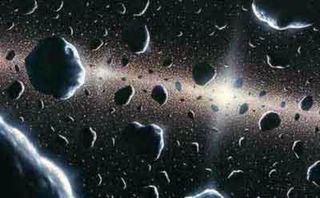By Hazel Muir
NewScientist.com news service
4-21-05
NewScientist.com news service
4-21-05
An alien asteroid belt may have been spotted circling a mature star nearby. The observations, made by NASA's Spitzer Space Telescope, reveal a dense ring of dust around the star that might arise from rocks colliding and smashing each other apart.
Alternatively, the dust could come from a “supercomet” almost the size of Pluto, said Charles Beichman of the California Institute of Technology in Pasadena, US, at a NASA news conference on Wednesday.
Beichman and his colleagues used Spitzer to observe more than 80 Sun-like stars, including one called HD69830, which lies 41 light years away. Its infrared spectrum suggested it has a thick disc of warm dust grains surrounding it. The dust could be produced in a busy asteroid belt if large rocks are colliding every 1000 years or so, replenishing the ring.
“These grains are probably the signpost of an asteroid belt around 25 times more massive than that orbiting our own sun,” says Beichman. The dust seems to lie inside an orbit equivalent to that of Venus, much closer to its star than our own asteroid belt, which lies between Mars and Jupiter.
Earlier observations had revealed asteroid belts around young, massive stars. But HD69830 is a mature star, about half the age of the Sun and with 20% less mass. If confirmed, the new asteroid belt would be the first detected around a star similar to the Sun.
Rubble shepherds
“We’re really interested in understanding more about the asteroid belts of mature stars, because they tell us more about our own sun and whether our own planetary system is the norm or exceptional,” says Beichman.
Astronomers say the amount of rubble is surprising because debris around stars tends to disperse over time. They suspect a giant planet might be trapping the rubble in orbit, just as Jupiter’s gravity shepherds rocks in our own asteroid belt into a series of bands.
However, so far there have been no direct sightings of any planets around HD69830. And if any existed in the warmer inner regions of the system, they would probably be hostile to life. They would be pelted with rubble and suffer mass extinctions of any life every million years or so, Beichman expects.
A second possibility is that the dust around HD69830 comes from a giant comet slowly boiling away near the star. But to generate so much dust, the comet would have to be at least 25 times bigger than comet Hale-Bopp, which blazed spectacularly through the skies in 1997. And the required close-in orbit would mean the comet would boil away relatively quickly, making this scenario rather far-fetched.
Beichman hopes future observations of the star by Spitzer and other telescopes will discover the true source of the dust by pinning down its detailed chemical make-up.
Home

No comments :
Post a Comment
Dear Reader/Contributor,
Your input is greatly appreciated, and coveted; however, blatant mis-use of this site's bandwidth will not be tolerated (e.g., SPAM, non-related links, etc).
Additionally, healthy debate is invited; however, ad hominem and or vitriolic attacks will not be published, nor will "anonymous" criticisms. Please keep your arguments/comments to the issues and subject matter of this article and present them with civility and proper decorum. -FW